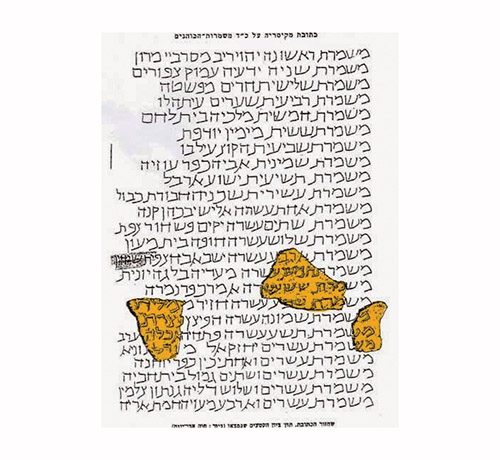

There is an enigmatic individual, a high priest in the Jerusalem Temple, mentioned in the Mishnah, Tractate Parah מסכת פרה פרק ג’ משנה ה by the name of Elyehoanay ben Hakof. He is counted among a select number of high priests who sacrificed a para aduma (red heifer).
As mentioned, there is a sole reference to this individual in Rabbinic literature.
However, Rambam “elevates” him to the role of one of the transmitters of the mesorah (tradition) in his Introduction to the Mishnah:
והחבורה החמישית, חוני המעגל, ואליהועיני בן הקף, ויהודה בן טבאי, ושמעון בן שטח.
“And in the fifth group: Choni Ha-meagel and Elyehoanay ben Hakof.”
This is interesting, since he is not mentioned as such in Tractate Avot where the chain of transmission is recorded. In fact, as I mentioned, he gets no mention at all anywhere else in the vast Rabbinic corpus.
Additionally, “ben hakof” is a strange term for a High Priest. And while we do find an Aramaic rendition of “kof” (which means monkey), namely Caipha or Caiphas of New Testament fame (I have come across other variants of his patronym; also according to one explanation, his name is supposedly derived from the Aramaic word for “the fat of boiled meat” and not monkey). Is it possible that the proper rendering of his name is “ben hakoz” and not “hakof”? In other words, there would be a tzade sofit, rather than a peh sofit.
As you can see in the attached photo (which is a reconstruction of an archaeological find from a circa third or fourth c. synagogue in Caesarea), the Hakotz family of kohanim were one of the 24 (mishmerot kehuna) priestly shifts and are already mentioned in Ezra (although they were considered to be of questionable lineage, but they seemed to have eventually been rehabilitated into the priesthood). The Hakotz family is also mentioned in the remarkable Temple Scroll from the Dead Sea Scrolls:
“In the cave that is next to (illegible), belonging to the House of Hakkoz, dig six cubits. There are six bars of gold.”
We also come across a “ben Hakotz” in the Apocrypha; in Maccabees I, אבפולימוס בן יוחנן בן הקוץ is one of the peace emissaries sent to Rome at the behest of Judah Maccabee.
The name Elyehoanay itself is also not a very common one. It appears only several times in Tanach. It also comes down to us from an epitaph of a Jewish man of possibly priestly lineage from third-century BCE Egypt.
Here’s a really interesting take from Sefer Ma’aseh Merkavah (see page 21, verse Reish-Nun-gimmel [253]), where his name is spelled
Elijah Unna ben Hakof
אליהו עונא בן הקוף
Parenthetically, speaking of Caipha (which is presumably the Aramaic rendition of Qof), the late Genizah expert Dr. Moshe Gil has an interesting theory about the extremist Islamic canard that Jews descend from monkeys and pigs; he connects it to the alleged emigration of the families of the distinguished priestly clans of Hezir and Hakof to the Arabian Peninsula post destruction of the Temple.
I should also mention that Rabbi Yekutiel Yehuda Greenwald in his biography of Jewish hHigh priests, תולדות הכהנים הגדולי, holds out for the possibility that our high priest was a son of Joseph Caiphas.�
On the Caiphas family see Tractate Yevamot� [ועל משפחת] בית קופאי מבית מקושש [שהן] בני צרות ומהם כהנים והיו מקריבין [לגבי מזבח]
The famed Rabbi Hayyim Yosef David Azulai, known as Chida, cites a strange theory wherein he maintains that Eliyahu and Einay were two separate individuals
Here’s a really wild theory: According the Kabbalist Rabbi Yissachar Eilenberg in his book “Be’er Sheva,” our high priest was the author of the midrash Tanna d’Bei Eliyahu. The Chida, however, vociferously disputes this.
By Joel S. David Weisberger
Joel S. Davidi Weisberger runs “Luach Libekha-Tablet Of Your Heart” and “Channeling Jewish History” (find them on Facebook).You can reach him� at [email protected].













